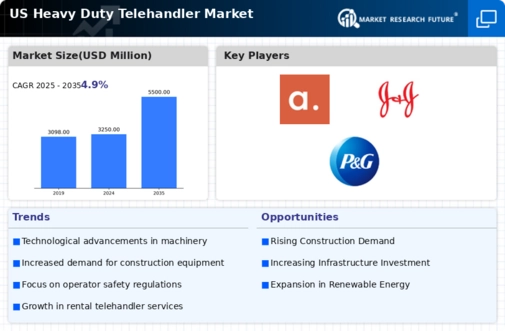Labor Shortages
Labor shortages in the construction industry are driving the demand for heavy duty-telehandlers, as companies seek to maximize productivity with fewer workers. The current labor market indicates a significant gap in skilled labor, prompting construction firms to invest in machinery that can perform multiple tasks efficiently. Telehandlers, known for their versatility, can replace several manual labor functions, thereby streamlining operations. This trend suggests that the heavy duty-telehandler market will continue to thrive as businesses adapt to labor constraints by leveraging machinery to maintain output levels and meet project requirements.
Increased Rental Demand
The heavy duty-telehandler market is witnessing a shift towards rental models, as companies prefer to rent equipment rather than purchase it outright. This trend is particularly pronounced in the construction sector, where project-based work often leads to fluctuating equipment needs. In 2025, the rental market for construction equipment is expected to grow by around 7%, indicating a strong preference for flexible solutions. Renting telehandlers allows companies to access the latest models without the burden of ownership costs, thus driving growth in the heavy duty-telehandler market as rental companies expand their fleets to meet rising demand.
Technological Integration
The integration of advanced technologies into the heavy duty-telehandler market is transforming operational efficiency and safety. Features such as telematics, automated controls, and enhanced safety systems are becoming standard in modern telehandlers. These innovations not only improve performance but also reduce operational costs. For instance, telehandlers equipped with telematics can provide real-time data on equipment usage, leading to better maintenance practices and reduced downtime. As companies increasingly prioritize technology to optimize their operations, the heavy duty-telehandler market is likely to see a surge in demand for technologically advanced models, reflecting a shift towards smarter construction practices.
Rising Construction Activities
The heavy duty-telehandler market experiences a notable boost due to the increasing construction activities across the United States. With infrastructure projects gaining momentum, the demand for heavy machinery, including telehandlers, is on the rise. In 2025, the construction sector is projected to grow by approximately 5.5%, leading to a heightened need for equipment that can handle heavy lifting and material transport. Telehandlers are particularly valued for their ability to operate in confined spaces while providing substantial lifting capabilities. This trend indicates a robust market environment for heavy duty-telehandlers, as construction companies seek efficient solutions to meet project deadlines and enhance productivity.
Regulatory Compliance and Safety Standards
The heavy duty-telehandler market is influenced by stringent regulatory compliance and safety standards imposed by government agencies. As safety regulations become more rigorous, construction companies are compelled to invest in equipment that meets these standards. Telehandlers equipped with advanced safety features, such as stability monitoring and operator assistance systems, are increasingly sought after. This focus on safety not only protects workers but also minimizes liability for companies. Consequently, the heavy duty-telehandler market is likely to expand as manufacturers innovate to meet evolving safety requirements, ensuring that their products align with industry regulations.














Leave a Comment